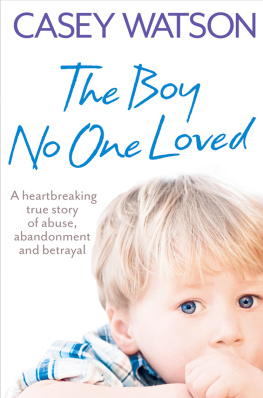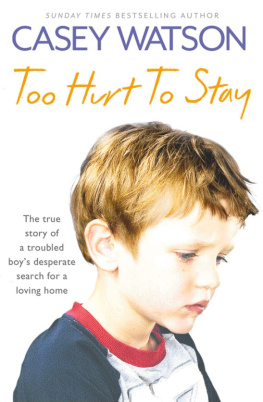
1
Im never lucky!
The first time we ever saw Keeley was in a Pizza Hut. She was having lunch with her social worker, and it had been arranged that my husband, Jonathan, and I would turn up casually, as if by chance.
Unfortunately Keeleys current placement is breaking down, our support social worker, Sandy, had explained over the phone. Wed like to move her as soon as possible, but she doesnt know yet. Do you think you could go and meet her, see what you think?
Its uncommon but not unheard of for Social Services to set up a meeting like this: supposedly bumping into a social worker and a child in a relaxed setting like Pizza Hut means there is no pressure or expectation on either side.
I felt optimistic when I agreed to the plan. In the seventeen years wed been fostering, Jonathan and I had only ever met one child we didnt think we could look after a teenage girl who instantly gave us both the same uncomfortable feeling that we simply werent right for her. Neither of us could put our finger on exactly why this was the case, but we decided it was wise to follow our gut instinct. We were completely honest with the social workers and the placement went no further. Im sure it was the right thing to do, as you need to feel positive and confident, for everybodys sake, when you take a new child into your home.
What can you tell me about Keeley? I asked Sandy enthusiastically.
This was my typical reaction whenever a potential new foster child was mentioned. It was 2004 now, and Jonathan and I were in our late forties. Wed looked after more than thirty youngsters over the years, yet I never failed to feel a surge of excitement at the prospect of caring for another one.
Sandy began by explaining that Keeley was eight years old, an only child and had been in and out of foster care since she was five. In that time she had stayed with four sets of carers on short-term placements, to give her mother occasional breaks, and over the past twelve months she had been in full-time care with two different families.
Why have the full-time placements not worked out? I asked. What seems to be the problem?
Keeleys bad behaviour. Both foster carers tell similar stories. Keeleys behaviour got worse instead of better as time went on, and both carers reached breaking point after several months, saying they simply couldnt manage with her any longer. Thats why were keen for you to take her on, Angela. Im sure youll do a brilliant job.
I appreciated the compliment. Sandy was in her fifties and had a very no-nonsense attitude that seemed to entirely fit with her smart and sensible appearance. I respected her, and receiving praise from Sandy meant a great deal. Knowing that our efforts were appreciated never failed to give me a lift. Even though Jonathan and I always work as a team, fostering can be an isolated job as you are working independently in your own home, typically keeping in contact with social workers on the phone rather than seeing them in person.
After starting out as foster carers in the late eighties, for many years Jonathan and I had also been providing specialist care for children whose placements in mainstream foster homes had broken down, and who needed some extra help. We heard about the need for specialist carers through an advert on the local radio in the nineties and, after putting ourselves forward, Jonathan and I underwent extensive training in looking after teenagers with complex needs. The training was ongoing and we still do it to this day, to sharpen our fostering skills and keep up to date with new research and methods of caring for difficult children.
Even though the training courses and workshops are designed to help us deal specifically with teenagers, Social Services often call on us to help when a younger child like Keeley has nowhere else to go, because mainstream fostering is not working and they might otherwise end up in a special unit. Foster children of all ages who come to us for specialist care are generally expected to stay between three and six months before being returned to mainstream care or going back to live with family, although there are no hard and fast rules. Over the years some youngsters have stayed with us for many years after ostensibly arriving for a brief respite stay.
I arranged a time for Jonathan and I to arrive at Pizza Hut on the coming Saturday afternoon, having organised for our part-time assistant to cover us over the busy lunchtime in the florists. Once the meeting had been confirmed, Sandy called me back and gave me some more background information on Keeley.
She was on the Child Protection Register under the category of emotional abuse before she came into care, Sandy said, reading from a file. Keeleys mother, Tina, has been unable to bond properly with her daughter since birth. Tina has a long history of mental illness, which has resulted in her being sectioned on a number of occasions. There are reports that Keeley was smacked regularly with a slipper and locked in an empty box room when she was naughty. Her birth father has never been on the scene, but her maternal grandfather, Eric, lives next door and is a regular visitor to the family home. On a number of occasions Tina has accused Eric of sexually abusing her when she herself was a child, but nothing has ever been proven and Tina has always refused to take this further or press charges. Unfortunately, there are concerns that Keeley may have also been sexually abused by Eric, and possibly also by her mother.
I see, I said quietly, disturbed by the detail, and particularly the suspicion of sexual abuse within the family and from mother to child.
Again, nothing has been proven with regard to the suspicions about Tina, Sandy continued. The concluding note in the file states: It appears the lack of early years bonding and the negative attitude of Keeleys mother towards her child has affected Keeleys ability to interact and function socially, resulting in her sustained bad behaviour.
There they are, I whispered to Jonathan as we walked into Pizza Hut. He followed my gaze to a large booth in the centre of the busy restaurant, where Keeleys social worker, Joan, was installed behind a large bowl of salad. Wed know Joan for many years and were very fond of her. She looked more like an ebullient grandmother than an extremely professional and efficient social worker of some thirty years experience, and she had a wonderful rapport with children and foster carers alike.
Settling into the seat beside her was a striking-looking young girl with an olive complexion, deep brown eyes and a mass of long black curly hair that was held back from her face with a bright red hairband. My first thought was that Keeley looked more Spanish than English, and to add to this image she was wearing a red and white polka-dot dress with a wide, red silk ribbon tied around her waist.
Here goes, I muttered to Jonathan as we casually approached the booth. I was just about to feign surprise in bumping into Joan when she threw out her arms.
Angela! Jonathan! she exclaimed brightly. How lovely to see you both! How are you? Why dont you join us?
Oh hi, Joan, I smiled. Its good to see you too, and that would be lovely. Is there space for us?
Of course. We can shuffle up a bit, cant we, Keeley? Angela and Jonathan, this is Keeley.
Pleased to meet you, we both said, smiling at Keeley.
Hello, she replied, shooting us a rather unfriendly look as she moved in closer to Joan, sliding her fizzy drink swiftly across the table as she did so. Unfortunately, the next moment the large glass hit a groove in the table top and toppled over, splashing lemonade onto Keeleys pretty dress.
Next page
















